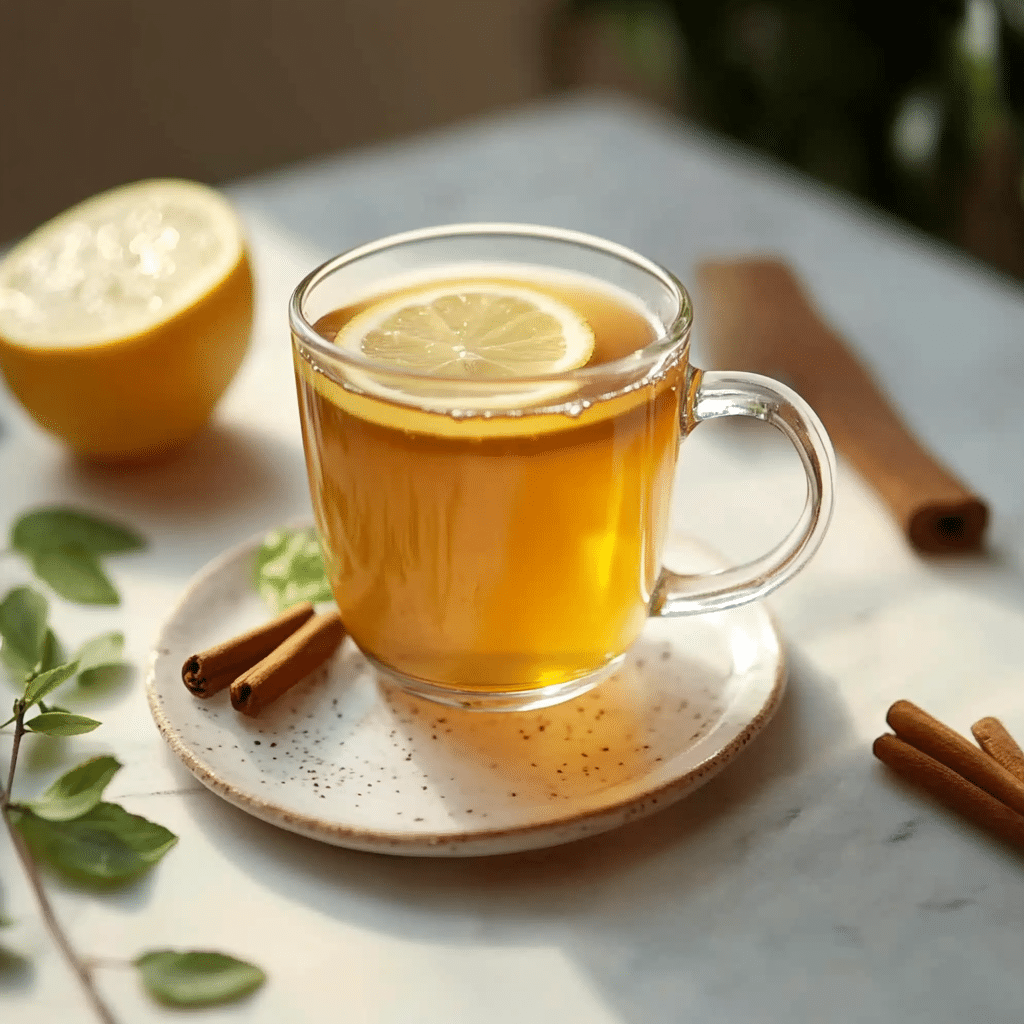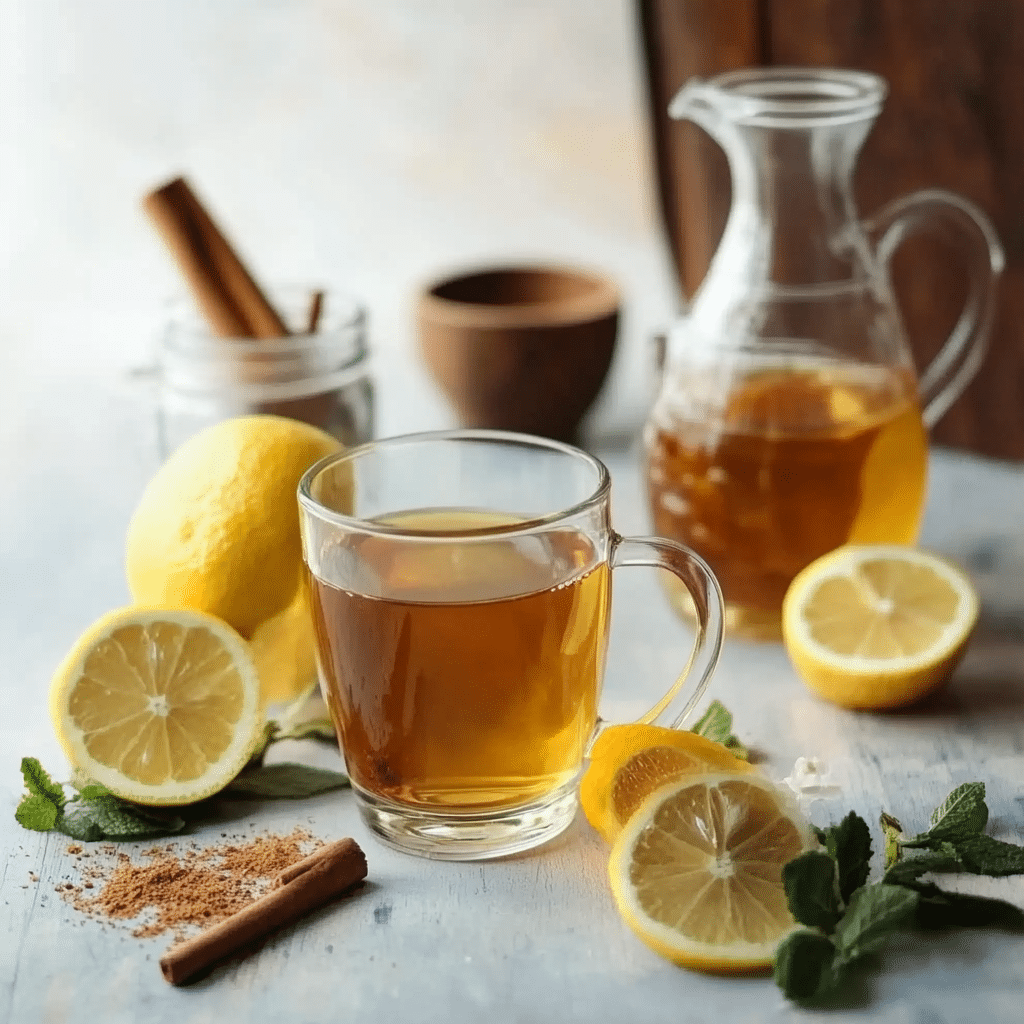The Ozempic tea recipe is gaining traction as a natural alternative for those seeking weight management support without prescription medication. Inspired by the effects of Ozempic—a popular drug for blood sugar and appetite control—this tea harnesses powerful natural ingredients to boost metabolism, curb cravings, and enhance energy levels.
Many people are turning to herbal solutions for a more holistic approach, and this recipe delivers just that. Learn more about natural drink alternatives like our Natural Ozempic Drink to see why people are swapping pills for tea.
In this guide, we’ll explore how to make Ozempic tea at home, why it works, variations you can try, when to drink it, and everything you need to know before adding it to your wellness routine.

Table of Contents
What is Ozempic Tea Recipe and Why is it Popular?
What Is Ozempic, and Why Explore a Tea Recipe Alternative?
Ozempic is a brand name for semaglutide, a medication known for improving blood sugar control and supporting weight loss. It works by mimicking a hormone that helps regulate appetite, resulting in fewer cravings and more stable energy levels. However, not everyone wants or needs prescription medication. The Ozempic tea recipe is designed as a natural alternative using ingredients that may provide similar benefits without pharmaceutical intervention.
The growing popularity of this recipe stems from the demand for herbal remedies that offer health support without side effects associated with drugs. People seeking natural ways to enhance metabolism and reduce hunger often find herbal teas more approachable and versatile.
Key benefits of the Ozempic tea recipe compared to medication
- Accessibility: While Ozempic requires a prescription, this tea can be made easily at home using affordable ingredients.
- No pharmaceutical side effects: Many people are concerned about nausea and digestive issues associated with semaglutide. This tea provides a gentler option.
- Customizable: The recipe allows you to adjust flavors and ingredients to suit your taste and health needs.
- Supports overall wellness: Aside from potential appetite control, this tea includes antioxidant-rich ingredients that support gut health, hydration, and energy levels.
Ingredients You Need for the Ozempic Tea Recipe
Core ingredients for natural Ozempic tea effects
The foundation of an Ozempic tea recipe focuses on ingredients that support appetite control and metabolism. Here are the key elements:
- Green Tea: Rich in catechins, green tea boosts metabolism and fat oxidation. It’s the most researched natural alternative to pharmaceutical weight control.
- Lemon: Packed with vitamin C, lemon enhances digestion and gives the tea a refreshing flavor.
- Ginger: Known for its thermogenic properties, ginger supports fat metabolism and reduces bloating.
- Cinnamon – Known for supporting healthy blood sugar levels and helping to curb cravings.
These four core ingredients work together to mimic some benefits associated with Ozempic by promoting satiety and energy balance naturally.
Optional add-ins for better flavor and health benefits
For a more personalized version of the Ozempic tea recipe, you can add:
- Hibiscus Flowers: Known for antioxidant properties and a tangy flavor. Check out our Hibiscus Tea Drink Recipes for more ideas.
- Chia Seeds: These add fiber and help with feeling fuller longer. See how they work in drinks with our Chia Lemon Detox Drink.
- Honey or Stevia: For a natural sweetness without spiking blood sugar.
- Mint Leaves: Adds freshness while aiding digestion.
These optional ingredients don’t just enhance flavor; they also support hydration, digestion, and overall wellness.
Step-by-Step Guide to Making Ozempic Tea Recipe
How to prepare the perfect metabolism-boosting tea
Ingredients:
- 1 Teaspoon Green Tea Leaves (or 1 Green Tea Bag) – Offers antioxidants and metabolism-boosting benefits.
- ½ teaspoon fresh grated ginger
- 1 cinnamon stick (or ½ teaspoon ground cinnamon)
- Juice of ½ fresh lemon
- 2 cups of water
Directions:
- Boil water: Bring 2 cups of water to a boil in a kettle or saucepan.
- Add ingredients: Remove from heat and add green tea, ginger, and cinnamon.
- Steep: Cover and let it steep for 5–7 minutes to allow nutrients to infuse.
- Strain and serve: Strain into a cup and add fresh lemon juice before drinking.
- Optional: Add chia seeds and let sit for 5 minutes if you want more fiber and thickness.
How Does the Ozempic Tea Recipe Work in the Body?
The science behind ingredients that mimic Ozempic’s effects
The Ozempic tea recipe doesn’t contain semaglutide but instead relies on natural compounds to support similar functions:
- Green tea catechins (EGCG): Shown to improve fat oxidation and increase metabolic rate.
- Gingerols in ginger: Stimulate digestion and may help suppress appetite by regulating serotonin receptors.
- Cinnamon polyphenols: Assist in stabilizing blood sugar levels, which can reduce cravings and hunger spikes.
- Lemon (Vitamin C) – Improves antioxidant absorption and aids natural detoxification.
When combined, these ingredients may mimic some mechanisms of Ozempic: appetite suppression, stabilized blood sugar, and improved metabolism—without pharmaceuticals.
Why tea blends can help with appetite control
Tea blends are an effective approach because they:
- Hydrate: Often, people mistake thirst for hunger. Drinking tea prevents this.
- Offer satiety: Warm beverages can create a feeling of fullness, reducing snack cravings.
- Provide slow-release caffeine: Green tea has moderate caffeine, which can boost energy and metabolism without the jitters associated with coffee.
- Deliver micronutrients: Herbal ingredients supply minerals and antioxidants that support overall wellness.
Comparing Ozempic Tea Recipe to Traditional Weight Loss Teas
How does Ozempic tea compare with green tea, oolong, and herbal blends?
Most commercial weight-loss teas focus on diuretics and high-caffeine stimulants, which often result in short-term weight loss from water loss, not fat burning. The Ozempic tea recipe, however, focuses on metabolic support and appetite suppression through balanced, natural ingredients:
- Green Tea Only: Offers metabolism boosting but lacks cinnamon’s blood sugar support.
- Oolong Tea: Good for fat metabolism but less effective for appetite control.
- Detox Teas: Often rely on laxatives, which can be uncomfortable and unsustainable.
The Ozempic tea recipe combines multiple benefits: metabolic support, blood sugar stability, and satiety enhancement—making it a better holistic choice.
What makes this recipe unique?
- Balanced formulation: Targets appetite, metabolism, and energy without extreme stimulants.
- Customizable: You can adjust ingredients to match taste preferences or dietary needs.
- Evidence-backed ingredients: Every ingredient has scientific research supporting its role in metabolism or appetite control.
Check out our Natural Mounjaro Recipe for another effective approach to natural appetite support.
Also, for something fun and unique, see the Johnny Vegas Shot Drink for a different take on wellness drinks.
Popular Variations of the Ozempic Tea Recipe
Green tea-based Ozempic alternative
This variation uses only green tea as the base but enhances it with additional fat-burning boosters:
- Ingredients: Green tea, lemon, ginger, a pinch of cayenne pepper, and a teaspoon of apple cider vinegar.
- Benefits: Adds thermogenic support, which may help speed up calorie burning and appetite regulation.
Hibiscus and citrus-infused version
Hibiscus is rich in antioxidants and supports healthy blood pressure, while citrus adds a fresh zing:
- Ingredients: Dried hibiscus flowers, green tea, lemon slices, and cinnamon.
- Benefits: Offers a tangy flavor, high vitamin C content, and an anti-inflammatory boost.
Looking for more inspiration? Try our Hibiscus Tea Drink Recipes for additional ways to incorporate this powerful ingredient.

When and How Often to Drink Ozempic Tea Recipe
Best times of day for optimal results
- Morning: Drinking on an empty stomach can jumpstart metabolism and provide early satiety, helping prevent mid-morning snacking.
- Before meals: 20–30 minutes before lunch or dinner can reduce appetite naturally and may lower overall calorie intake.
- Afternoon slump: A warm cup can replace sugary drinks and snacks, providing sustained energy.
Safe consumption guidelines
- Limit to 2–3 cups per day: Overconsumption of green tea can cause digestive discomfort due to its caffeine content.
- Stay hydrated: Complement tea consumption with water to avoid dehydration.
- Monitor your body: If you experience nausea, headaches, or sleep issues, reduce intake or switch to a caffeine-free version.
Potential Side Effects and Precautions
Who should avoid this tea recipe?
- Pregnant or breastfeeding women: Some ingredients, like high levels of caffeine and herbal blends, may not be safe.
- Individuals on medications: Cinnamon and ginger may interact with blood-thinning or diabetes medications.
- People with caffeine sensitivity: Substitute green tea with caffeine-free herbal tea if needed.
Interactions with medications and health conditions
Always consult your doctor before adding herbal remedies if you:
- Consult Your Doctor – Especially if you take medications for diabetes, blood pressure, or blood clotting.
- Have underlying gastrointestinal issues or acid reflux.
- Are managing severe chronic conditions.
FAQs About Ozempic Tea Recipe
What tea works like Ozempic?
Functional Teas – Appetite- and metabolism-supporting teas can mimic some effects of Ozempic, though they are not medical equivalents. Green tea, hibiscus tea, and ginger tea are popular for their metabolism-boosting and appetite-suppressing properties. While they don’t contain semaglutide, their natural compounds may help control cravings and support weight loss.
How do you make the Ozempic cortisol cocktail?
Ozempic Cortisol Cocktail – Specifically created to help manage stress-related cravings. A basic version includes:
Green tea (for metabolism support)
Lemon (vitamin C for cortisol regulation)
A pinch of pink salt (for electrolyte balance)
Honey (natural sweetness)
Mix ingredients in warm water and sip in the morning to stabilize cortisol levels naturally.
How much green tea is equivalent to Ozempic?
There’s no exact equivalent because green tea does not mimic Ozempic’s pharmaceutical properties. However, drinking 2–3 cups of green tea daily may provide similar appetite-control support and metabolic enhancement that some people find effective for weight management.
Does green tea actually act like Ozempic?
No, green tea doesn’t replicate the medical effects of Ozempic. It lacks GLP-1 receptor agonist properties but offers similar supportive benefits for metabolism and appetite regulation. For those seeking natural wellness, green tea is an excellent choice, but it should not replace medical treatments prescribed by a doctor.
Conclusion
The Ozempic tea recipe offers a natural, accessible, and customizable approach to supporting weight loss and appetite control. With a simple mix of green tea, ginger, cinnamon, and lemon, it provides antioxidant, metabolic, and appetite-regulating benefits—without requiring a prescription. Variations like hibiscus-citrus blends or chia seed infusions make it versatile and enjoyable.
If you’re looking to add more holistic wellness drinks to your diet, discover simple seed-based solutions with our Bariatric Seed Trick for additional natural approaches to appetite management. Wellness Focus – Explore natural recipes, healthy drinks, and daily wellness tips for a balanced lifestyle. Visit our page Facebook for the Ozempic Tea Recipe and more!
